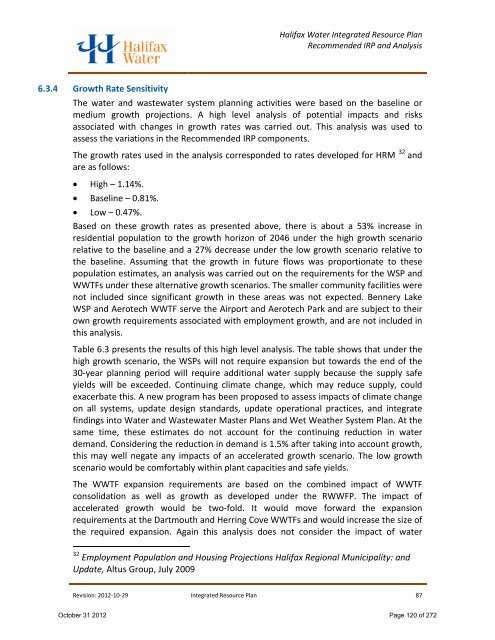volume 1 - Halifax Regional Municipality
volume 1 - Halifax Regional Municipality
volume 1 - Halifax Regional Municipality
You also want an ePaper? Increase the reach of your titles
YUMPU automatically turns print PDFs into web optimized ePapers that Google loves.
<strong>Halifax</strong> Water Integrated Resource Plan<br />
Recommended IRP and Analysis<br />
6.3.4 Growth Rate Sensitivity<br />
The water and wastewater system planning activities were based on the baseline or<br />
medium growth projections. A high level analysis of potential impacts and risks<br />
associated with changes in growth rates was carried out. This analysis was used to<br />
assess the variations in the Recommended IRP components.<br />
The growth rates used in the analysis corresponded to rates developed for HRM 32 and<br />
are as follows:<br />
• High – 1.14%.<br />
• Baseline – 0.81%.<br />
• Low – 0.47%.<br />
Based on these growth rates as presented above, there is about a 53% increase in<br />
residential population to the growth horizon of 2046 under the high growth scenario<br />
relative to the baseline and a 27% decrease under the low growth scenario relative to<br />
the baseline. Assuming that the growth in future flows was proportionate to these<br />
population estimates, an analysis was carried out on the requirements for the WSP and<br />
WWTFs under these alternative growth scenarios. The smaller community facilities were<br />
not included since significant growth in these areas was not expected. Bennery Lake<br />
WSP and Aerotech WWTF serve the Airport and Aerotech Park and are subject to their<br />
own growth requirements associated with employment growth, and are not included in<br />
this analysis.<br />
Table 6.3 presents the results of this high level analysis. The table shows that under the<br />
high growth scenario, the WSPs will not require expansion but towards the end of the<br />
30-year planning period will require additional water supply because the supply safe<br />
yields will be exceeded. Continuing climate change, which may reduce supply, could<br />
exacerbate this. A new program has been proposed to assess impacts of climate change<br />
on all systems, update design standards, update operational practices, and integrate<br />
findings into Water and Wastewater Master Plans and Wet Weather System Plan. At the<br />
same time, these estimates do not account for the continuing reduction in water<br />
demand. Considering the reduction in demand is 1.5% after taking into account growth,<br />
this may well negate any impacts of an accelerated growth scenario. The low growth<br />
scenario would be comfortably within plant capacities and safe yields.<br />
The WWTF expansion requirements are based on the combined impact of WWTF<br />
consolidation as well as growth as developed under the RWWFP. The impact of<br />
accelerated growth would be two-fold. It would move forward the expansion<br />
requirements at the Dartmouth and Herring Cove WWTFs and would increase the size of<br />
the required expansion. Again this analysis does not consider the impact of water<br />
32 Employment Population and Housing Projections <strong>Halifax</strong> <strong>Regional</strong> <strong>Municipality</strong>: and<br />
Update, Altus Group, July 2009<br />
Revision: 2012-10-29 Integrated Resource Plan 87<br />
October 31 2012 Page 120 of 272
















